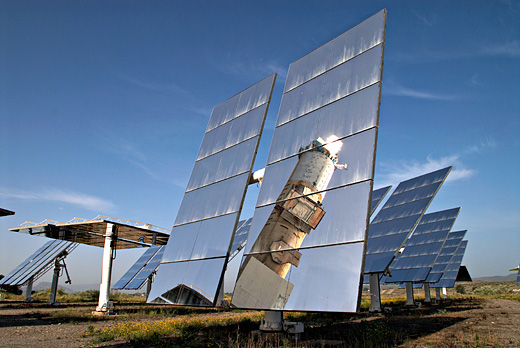

CESA-1
The CESA-I project, was promoted by the Spanish Ministry of Industry and Energy and inaugurated in May 1983 to demonstrate the feasibility of central receiver solar plants and enable the development of the necessary technology. At present, the CESA-1 does not produce electricity, but is a very flexible facility operated for testing subsystems and components such as heliostats, solar receivers, thermal storage, solarized gas turbines, control systems and concentrated high flux solar radiation measurement instrumentation. It is also used for other applications that require high photon concentrations on relatively large surfaces, such as in chemical or high-temperature processes, surface treatment of materials or astrophysics experiments.
Direct solar radiation is collected by the facility's 330 x 250-m south-facing field of 300 39.6-m2 heliostats distributed in 16 rows. The heliostats have a nominal mean 90% reflectivity, the solar tracking error on each axis is 1.2 mrad and the reflected beam image quality is 3 mrad. The CESA-1 facility has the most extensive experience in glass-metal heliostats in the world, with first generation units manufactured by SENER and CASA as well as second generation units with reflective facets by ASINEL and third generation facets and prototypes developed by CIEMAT and SOLUCAR. In spite of its over 20 years of age, the heliostat field is in good working condition due to a strategic program of continual mirror-facet replacement and drive mechanism maintenance and replacement. To the north of the field are two additional areas used as test platforms for new heliostat prototypes, one located 380 m from the tower and the other 500 away from it. The maximum thermal power delivered by the field onto the receiver aperture is 7 MW at a typical design irradiance of 950 W/m2, achieving a peak flux of 3.3 MW/m2. 99% of the power is focused on a 4 m-diameter circle and 90% in a 2.8 m circle.

The 80-m-high concrete tower, which has a 100‑ton load capacity, has three test levels:
- A cavity adapted for use as a solar furnace for materials testing at 45 m, which has been used very successfully in reproducing the heat ramp on space shuttles during their reentry into the atmosphere in test pieces of the ceramic shield and also for surface treatment of steels and other metal compounds.
- A cavity with a calorimetry test bed for pressurized volumetric receivers at 60 m.
- A multipurpose test facility for new receiver concepts at 75 m.
- A volumetric air receiver test facility at the top of the tower at 80 m.
The tower is complete with a 5-ton-capacity crane at the top and a freight elevator that can handle up to 1000-kg loads. Finally, for those tests that require electricity production, the facility has a 1.2‑MW two-stage turbine in a Rankin cycle designed to operate with 520ºC 100‑bar superheated steam.